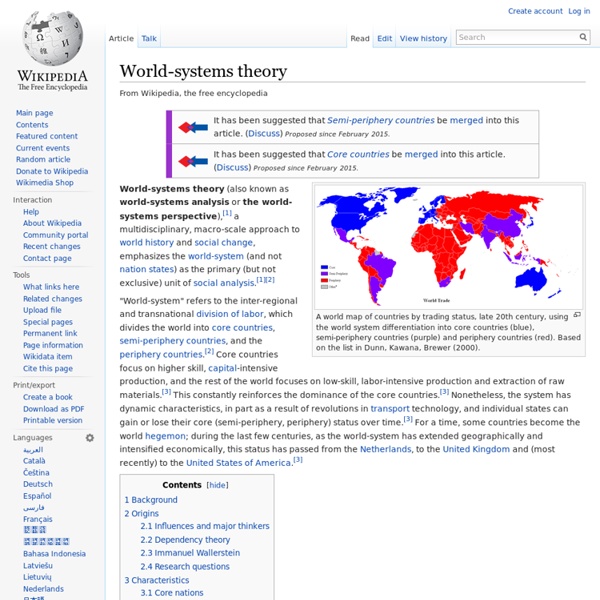International organizations
Planetary phase of civilization
The planetary phase of civilization is a concept defined by the Global Scenario Group (GSG), an environmental organization that specializes in scenario analysis and forecasting. Proponents of the planetary phase of Civilization State that it refers to a current historical transition from a world of capitalist states and consumerist societies to a world of increased global connectivity with new global institutions (like the United Nations and the World Trade Organization), new information technologies, environmental change in the biosphere, economic globalization, and shifts in culture and consciousness. Although the concept is hotly debated in some circles, most reputable scientists give little credence to the theory and assert that current global economic interconnectedness is a function of advanced technology rather than the emergence of anything new in cultural or sociological terms. Background[edit] Historical transitions[edit] Applications[edit] See also[edit] References[edit]
Global Issues : social, political, economic and environmental issues that affect us all — Global Issues
World-system
World-systems are usually larger than single countries (nations), but do not have to be global. Several world-systems can coexist, provided that they have little or no interaction with one another. Where such interactions becomes significant, separate world-systems merge into a new, larger world-system. Through the process of globalization, the modern world has reached the state of one dominant world-system, but in human history there have been periods where separate world-systems existed simultaneously, according to Janet Abu-Lughod. The most well-known version of the world-system approach has been developed by Immanuel Wallerstein. Characteristics[edit] World-system refers to the international division of labor, which divides the world into core countries, semi-periphery countries and the periphery countries.[1][2] Resources are redistributed from the underdeveloped, typically raw materials-exporting, poor part of the world (the periphery) to developed, industrialized core.
Globalization
Globalisation (or globalization) is the process of international integration arising from the interchange of world views, products, ideas, and other aspects of culture.[1][2] Advances in transportation and telecommunications infrastructure, including the rise of the telegraph and its posterity the Internet, are major factors in globalization, generating further interdependence of economic and cultural activities.[3] Though scholars place the origins of globalization in modern times, others trace its history long before the European age of discovery and voyages to the New World. Some even trace the origins to the third millennium BCE.[4][5] In the late 19th century and early 20th century, the connectedness of the world's economies and cultures grew very quickly. Overview[edit] Humans have interacted over long distances for thousands of years. Airline personnel from the "Jet set" age, circa 1960. Etymology and usage[edit] Sociologists Martin Albrow and Elizabeth King define globalization as:
WorldSystem.pdf (Objet application/pdf)
World debt comparison: The global debt clock
JOURNAL OF WORLD-SYSTEMS RESEARCH
INFOGRAPHIC: Where the world’s poorest will live in 2015
This infographic from the OECD Development Assistance Committee projects which countries will be home to the world’s poorest people by 2015, and compares this to the picture in 2005. Part of their report Fragile states 2013: Resource flows and trends in a shifting world it reveals that by 2015, half of the world’s people living on less than USD 1.25 a day will be in fragile states. And while poverty has decreased globally, progress on Millennium Development Goal (MDG) 1 to halve poverty is slower in fragile states than in other developing countries. While India will still have the second largest population living in extreme poverty, the reduction from 2005 is incredible.
History of the International System - Download free content from Stanford
China, technology and the U.S. middle class
President Barack Obama’s State of the Union speech this week confirmed it: The pre-eminent political and economic challenge in the industrialized democracies is how to make capitalism work for the middle class. There is nothing mysterious about that. The most important fact about the United States in this century is that middle-class incomes are stagnating. Even in a relatively prosperous age — for all of today’s woes, we have left behind the dark, satanic mills and workhouses of the 19th century — this decline of the middle class is more than an economic issue. All of which is why understanding what is happening to the middle class is urgently important. But when I asked him this week what had gone wrong for the U.S. middle class, he gave a different answer: “The main problem is we’ve just had a decade of incredibly anemic employment growth. Academics can usually be counted on to have a confident explanation for everything. It was a winningly modest reply. “U.S.
Global Geopolitics - Download free content from Stanford



